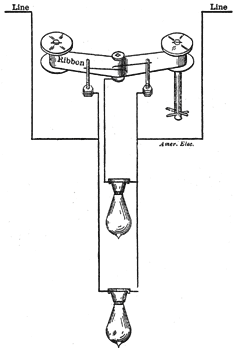[Trade Journal]
Publication: American Electrician
New York, NY, United States
vol. 14, no. 7, p. 367,368, col. 2-3,1
NEW
Apparatus
AND
Appliances.
·
·
SERIES INCANDESCENT LAMP FIXTURE.
Among the numerous systems of series incandescent street lighting is the Auto-electric shunt system, illustrated herewith. Though not very generally known, the system is employed by a large company operating in the neighborhood of 5000 series incandescent lamps over a district of 17 miles in one direction and 9 miles in another. It will be noted that the arrangement of lamps on the fixture, as shown by Fig. 21, is a radical departure from any of the older methods. Two lamps are used on each fixture, one above the other, the upper lamp being protected from stray missiles by a screen. In the casting which forms the top of the lamp fixture is placed the shunting device. Directly beneath this, the screen is fastened, from which hang the shade and receptacle for the main lamp. Fig. 20 is a diagram of the shunting mechanism and connections. A very thin silk ribbon is wound upon two spools and passes over a metal roller, shown in the center of the diagram. The left-hand lead from the upper lamp is connected permanently to this metal roller and two contact fingers press lightly upon the silk ribbon where the latter passes over the roller. When things are in their normal condition, the lower, or main, lamp is simply in series with the other lamps in the circuit. Should the lamp break, however, the silk ribbon between the metal roller and the contact finger on the left is subjected to the full potential of the circuit and is punctured at that point, allowing the finger to come in contact with the roller and thereby completing the circuit through the upper lamp.
 |
| Fig. 20. — Cut-Out Connections. |
Should this lamp also burn out, the ribbon is punctured under the right-hand contact finger, and the circuit is closed through the contact stud, and continues to operate with one lamp short in
 |
| Fig. 21. — Street Fixture. |
the series. When the inspector makes his rounds he replaces the lamps, and then turns the rod attached to the right-hand spool, winding up a portion of the ribbon sufficient to clear the punctures, when things are again in their normal condition. The system may be operated on any voltage, and is very flexible in that different series of lamps of different candle-powers may be used with the same shunt and fed from the same primary feeders. The system, more-over, possesses the obvious advantage of being immune from dead resistances or magnetic appliances requiring current in their operation and entailing loss; the only loss being that of transmission. The Auto Electric Shunt Company, of West New Brighton, Staten Island, N. Y., is the maker of these shunts and fixtures.
·
·
